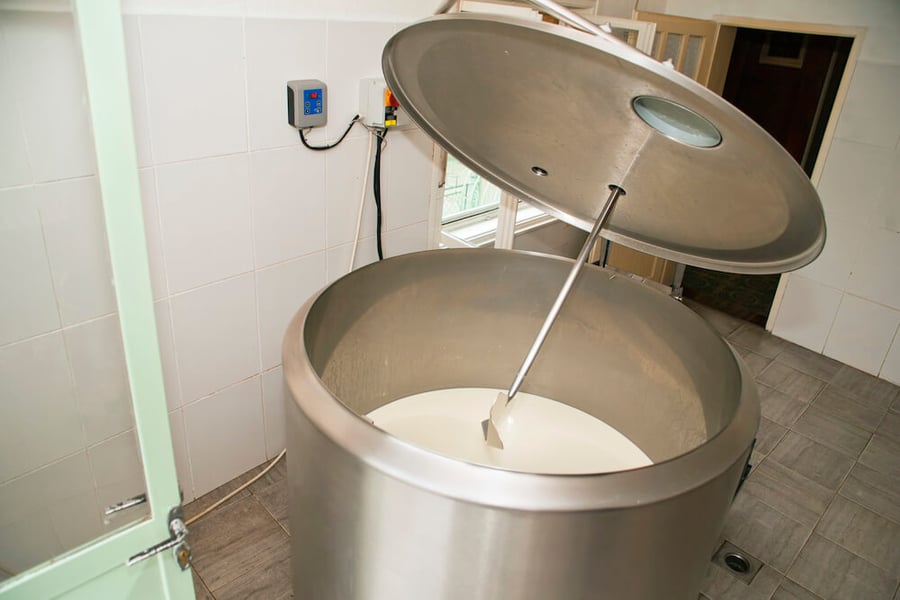The diagnosis of Q fever is sometimes difficult because the clinical picture is not specific to the disease. Indeed, abortions, metritis, retained placenta and other fertility disorders can have many causes.
Therefore, laboratory tests are essential for Coxiella burnetii diagnosis, the bacterium responsible for the disease.
Different types of tests for Coxiella burnetii diagnosis
As with any infectious disease, diagnosis can be direct or indirect. Direct diagnosis is the search for the pathogen itself. There are 3 main direct diagnostic techniques for Q fever:
- Staining from the biological sample. This technique has been widely used in the past on a placental cotyledon for the diagnosis of abortions. While it has the advantage of being simple to perform and inexpensive, it lacks sensitivity and can therefore only be applied when the sample is likely to contain a large amount of Coxiella burnetii. The diagnosis of Q fever by this technique should therefore be reserved for abortions.
- Bacterial culture: This is the standard technique for bacteriological diagnosis. However, as Coxiella burnetii is an intracellular bacterium which is difficult to culture in vitro, this technique cannot be used for routine diagnosis.
- Polymerase Chain Reaction (PCR) is used to identify the genetic material (DNA) of Coxiella burnetii. This technique is very sensitive and can be used on different types of samples: biological tissues such as placenta, vaginal swabs, faeces, milk (including bulk tank milk). It is also possible to diagnose Coxiella burnetii in environmental matrices such as dust.

Indirect diagnosis is based on the detection of antibodies produced by the animal in response to the infection. This means that we do not look for the bacteria itself but for the immune response it has triggered. Samples for indirect Coxiella burnetii diagnosis are blood and milk, including bulk tank milk. Different techniques exist:
- The immunofluorescence (IF)
- The complement fixation test (CFT)
- The enzyme-linked immunosorbent assay (ELISA). This is currently the most commonly used method in routine diagnosis because it is rapid and easily automated. Therefore, it is more interesting from an economic point of view.

Which tests to choose ?
The choice of the method for Coxiella burnetii diagnosis should be based on the objective to be achieved:
- Do we want to know if an animal is or has been infected or if an abortion is related to Q fever?
- Do we want to know if the herd is infected?
- Do we want to obtain epidemiological data to determine Q fever prevalence in a region or country?
Individual diagnosis
Direct individual tests are of interest for the diagnosis of an abortion. The analysis is then carried out on the placenta or the stomach contents of the foetus. In all other cases, direct individual diagnosis is of little value because the excretion of the bacteria in milk, vaginal discharge and faeces is intermittent. The risk of a false negative Coxiella burnetii diagnosis is therefore high, unless several samples are taken several days apart and from different matrices, in which case the cost of testing becomes high.
Outside of abortion cases, individual diagnosis is therefore based on indirect diagnosis by serology. This type of analysis makes it possible to know whether the animal has been in contact with the bacteria during its life. However, it is impossible to know, by this method, if the animal sampled is still infected, and therefore potentially a shedder of the bacteria. An overestimation of the infection is therefore possible. Furthermore, an animal vaccinated against Q fever may also have a positive result without being infected with Coxiella burnetii.
Herd diagnosis
At the herd level, both types of diagnosis (direct and indirect) are possible.
Indirect diagnosis by serology on blood or milk allows to know if the herd has been exposed to the bacteria. However, for reliable Coxiella burnetii diagnosis, it is desirable to sample a sufficient number of animals. Even in a heavily infected herd, it is rare that more than 50% of the animals have antibodies against the disease. If sampling is too low, there is a risk of false negative results.
For dairy herds, serological testing can also be performed on bulk tank milk.
As with individual diagnosis, a positive result will not indicate whether the bacteria is still circulating in the herd or whether it was present in the past but is no longer present. Finally, this technique should not be used in herds vaccinated against Q fever, as antibodies produced as a result of vaccination may be detected and cannot be distinguished from those resulting from infection.
Direct herd diagnosis has the advantage that the bacteria itself can be detected. A positive result therefore provides evidence of actual infection in the herd on the day of sampling. For dairy cattle or goat farms, the most interesting method is PCR on bulk tank milk. Indeed, this method is reliable and economically interesting. However, for dairy sheep farms, this technique is not feasible because, unlike cows and goats, many ewes, even if infected, do not shed the bacteria into the milk. A high proportion of false-negative results is therefore to be expected.
For non-dairy farms, regardless of the species, a reliable result can only be obtained by taking multiple vaginal swabs or faeces samples. This multiplies the costs of the analyses. An alternative, so far only validated for small ruminant farms, is the Coxiella burnetii diagnosis on dust collected in the stables.
Epidemiological diagnosis
Epidemiological diagnosis can be seen as an extension of herd diagnosis. Consequently, two methods can be considered:
- in dairy herds of goats or cows, PCR on tank milk.
- for all species and all types of farming, serology on blood or milk is possible.
Key messages
The table below summarises the different contexts and possible methods:
|
|
Individual |
Herd |
Epidemiological study |
|||
|
Abortion |
Others |
Dairy cows and goats |
Others |
Dairy cows and goats |
Others |
|
|
Direct (PCR) |
+++ |
- |
+++ (BTM) |
+/- (Several samples needed) |
++ (BTM) |
- |
|
Indirect (Serology) |
- |
+/- |
+ |
+ |
++ |
++ |
About the author
Philippe Gisbert (Ruminants Global Technical Manager)
Philippe Gisbert started his career in 1994 as a Vet practitioner working with companion and farm animals for over 9 years. He then became Health Affairs Manager for Group Agena (artificial insemination company). In 2008 he joined Eurofins – Laboratoire Coeur de France as Animal Health Unit Manager where he worked for 7 years until he joined Ceva France as Technical Manager Ruminants (Infectiology, Vaccines and Diagnostic). Since 2020 he is Global Technical Manager for Biologicals, Udder Health and Antiinflammatories. He is a member of SIMV diagnostic and anti-infective technical groups and has integrated different working groups of ANSES and UNCEIA related to epidemiology, antibiotic resistance and reproduction in livestock.
Explore author’s articlesFrequently Asked Questions
-
Is Coxiella burnetii difficult to treat?
Antibiotics are of limited efficacy in the control of Q Fever in ruminants. The control of Q fever in ruminant herds involves non-medical measures (biosecurity) and animal vaccination. The commercially available vaccine reduces both the clinical signs of the disease, such as abortions, and the shedding of the causative bacteria. -
What are the clinical findings of Q fever?
Q fever is essentially a reproductive disease in ruminants. The clinical signs are abortions, weak newborns, stillbirths, placental retention, metritis/endometritis and more generally fertility disorders. -
How is Coxiella burnetii treated?
As, in ruminants, medical treatment (antibiotics) are not efficient to treat the disease, the best way to control Q fever is to prevent it by biosecurity measures and vaccination. However, in an infected herd, vaccination has also been shown to reduce the clinical impact of the disease and to reduce the shedding of the bacteria by the animals. -
Can Coxiella burnetii be treated with antibiotics?
Because the effect of antibiotic treatment is not evidence-based and prudent use of antibiotics is needed to avoid microbial resistance, it is advised that antibiotics should not be used for treatment of Q fever in animals. The control of Q fever in ruminant herds involves non-medical measures (biosecurity) and animal vaccination. The commercially available vaccine reduces both the clinical signs of the disease, such as abortions, and the shedding of the causative bacteria.


Leave your comments here